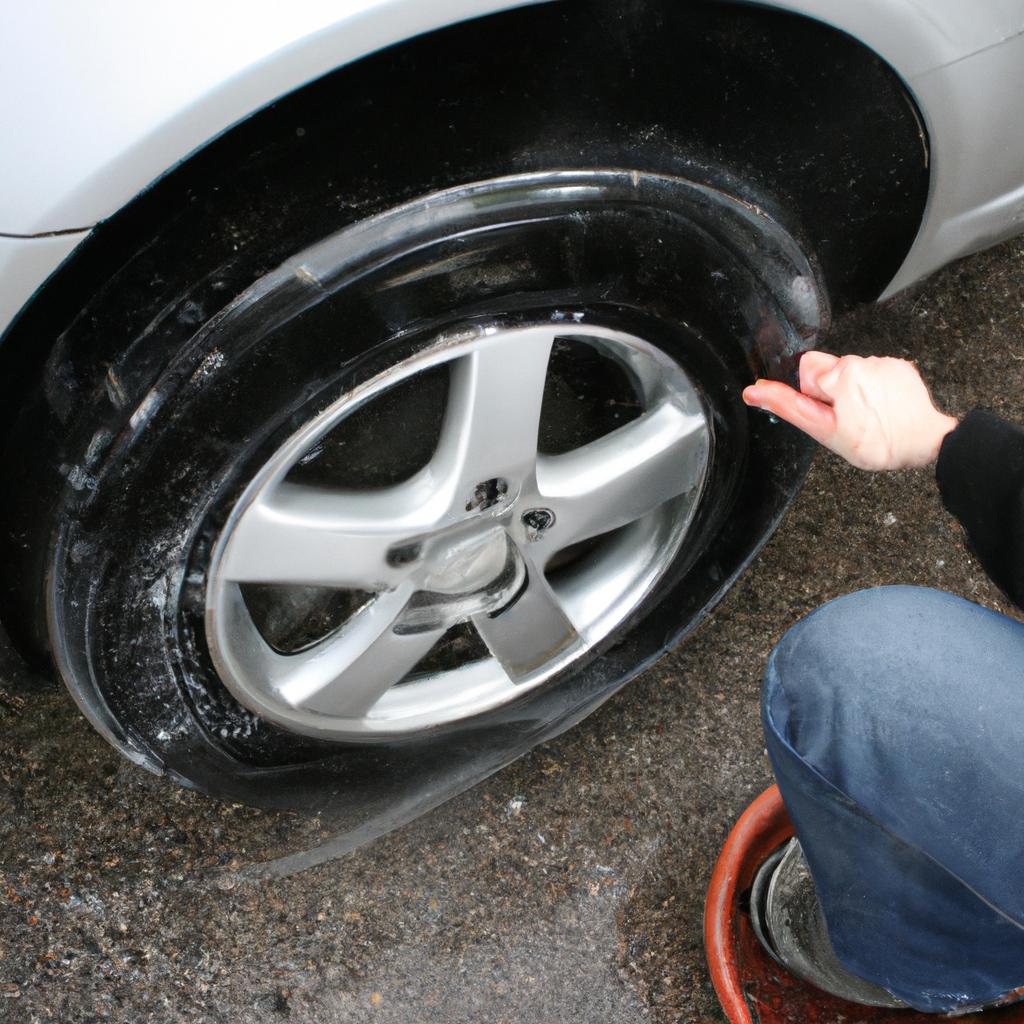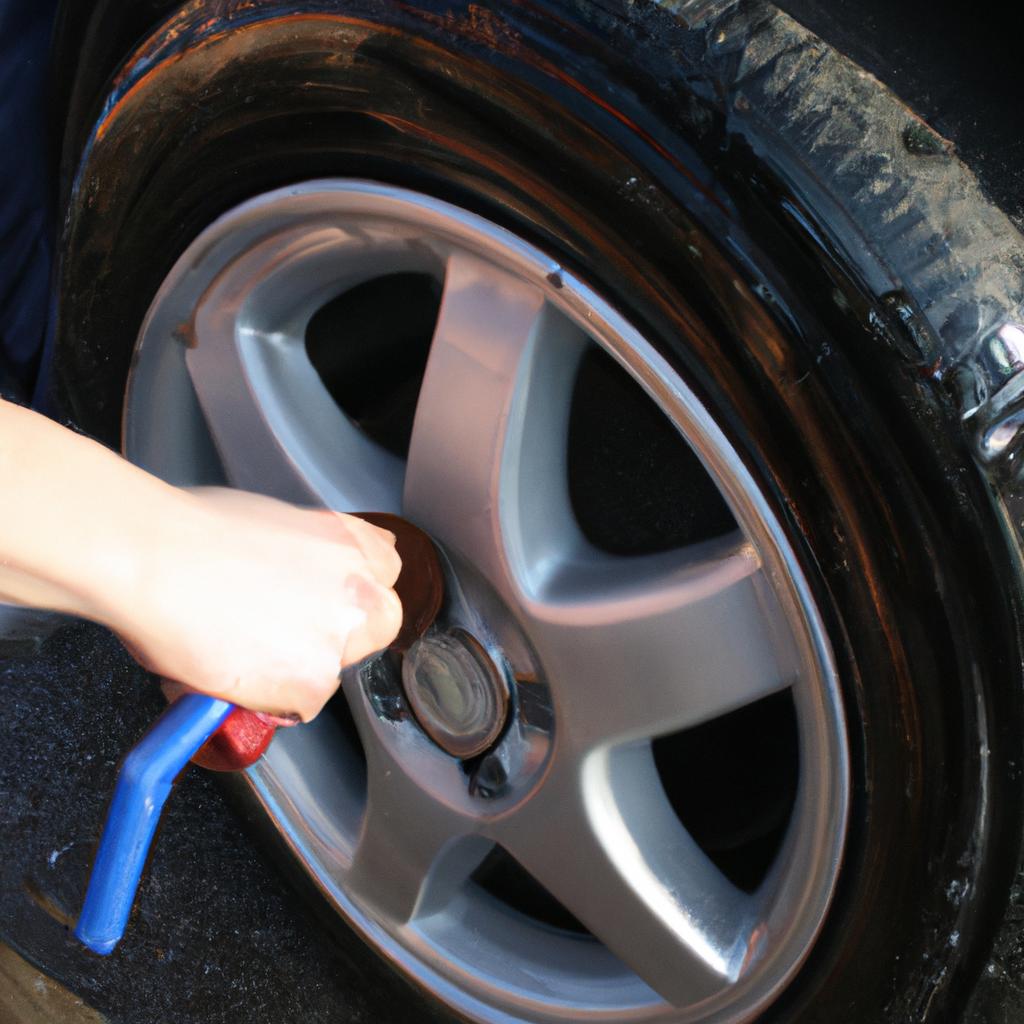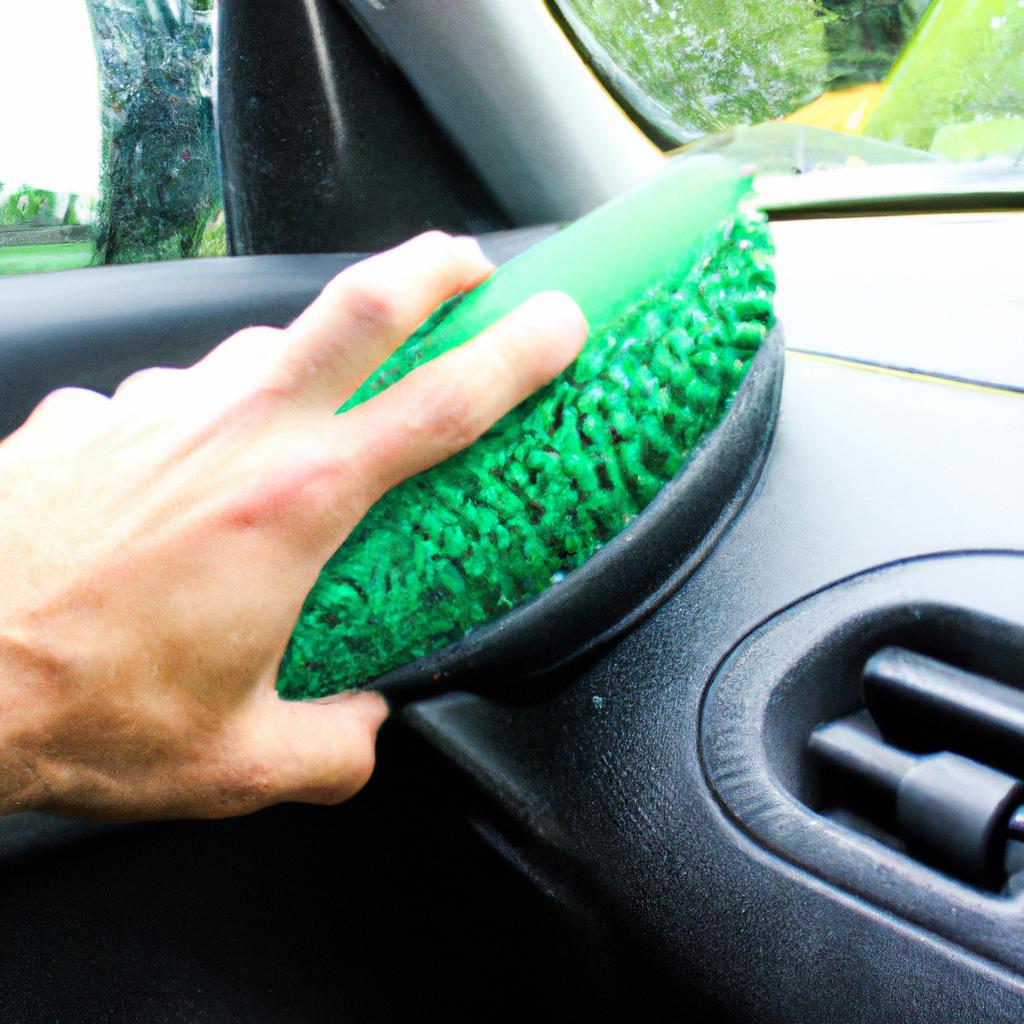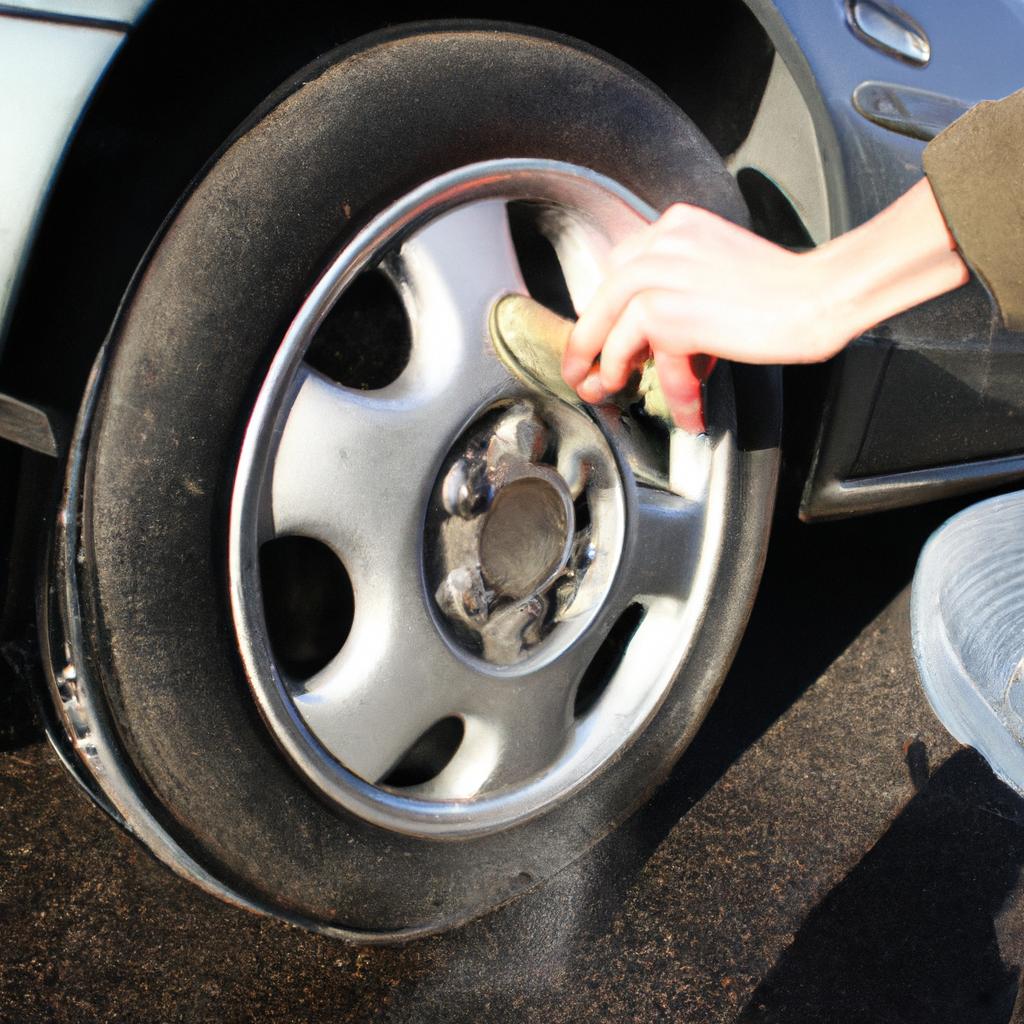Introduction
Wheel wells are an often overlooked part of a vehicle’s exterior when it comes to regular cleaning routines. However, neglecting this area can lead to the accumulation of dirt, grime, and debris that not only affects the overall appearance of the car but also compromises its functionality. For instance, imagine a hypothetical scenario where you are driving through muddy terrain and your wheel wells have not been properly cleaned for weeks. As you navigate through puddles and rough roads, the accumulated mud and filth continuously splatters onto other parts of your car, making it difficult to maintain a clean exterior. To avoid such situations and ensure optimal cleanliness, it is crucial to understand how to effectively clean wheel wells.
In this comprehensive guide on cleaning wheel wells, we will explore various techniques and strategies that can help you achieve pristine results. The aim is not just superficial cleanliness but also maintaining the longevity of your vehicle by preventing rust formation and other potential damages caused by neglecting these areas during routine washing sessions. By following our step-by-step instructions and utilizing recommended tools and products, you will be able to tackle even the toughest dirt buildup in your wheel wells with ease. Whether you are a professional detailer or a car enthusiast looking to enhance the aesthetic appeal of your ride, this guide will provide you with all the information and guidance you need to effectively clean your wheel wells.
Why Cleaning Wheel Wells is Important
Imagine driving down a dusty road, enjoying the scenic views when suddenly your car hits a pothole. The impact sends a cloud of dirt and debris into the air, some of which finds its way into your wheel wells. While this may seem like a minor inconvenience, neglecting to clean your wheel wells can have long-term consequences for both the appearance and functionality of your vehicle.
1. Prevents corrosion: One of the primary reasons why cleaning wheel wells is important is that it helps prevent corrosion. Over time, dirt, salt, and other contaminants accumulate in these areas, creating an ideal environment for rust to develop. As rust spreads, it weakens the structural integrity of your car’s body, leading to costly repairs or even safety hazards.
2. Enhances aesthetics: Clean wheel wells contribute significantly to the overall visual appeal of your vehicle. When you take pride in maintaining a clean exterior, including properly cleaned wheel wells, it reflects positively on your attention to detail and personal hygiene standards as a car owner.
3. Improves braking performance: Another crucial benefit of keeping your wheel wells clean is improved braking performance. Brake components are often located near or within the wheel well area, so any buildup of grime or debris can hinder their proper functioning. By regularly cleaning this part of your car, you ensure optimal brake operation and reduce the risk of accidents caused by impaired stopping power.
4. Extends tire life: Dirty wheel wells can also affect tire longevity. Accumulated mud and dust increase moisture retention around tires’ sidewalls and treads, accelerating wear and tear over time. Cleaning out these areas not only removes potentially damaging substances but also allows you to inspect for any signs of damage or uneven tread wear that may require professional attention.
To summarize, cleaning your car’s wheel wells not only helps prevent corrosion but also enhances its aesthetic appeal while improving braking performance and extending tire life. Neglecting this crucial maintenance task can lead to costly repairs and compromise the overall safety of your vehicle.
Tools and Materials Needed for Wheel Well Cleaning
Imagine this scenario: You are driving down a muddy road after a rainstorm. The tires of your car kick up dirt and debris, which inevitably finds its way into the wheel wells. Over time, these accumulations can lead to serious consequences for both the appearance and performance of your vehicle.
One major reason why cleaning wheel wells is important is that it helps prevent rust and corrosion. When mud, salt, or other contaminants accumulate in the wheel wells, they create an ideal environment for moisture to linger. This excess moisture can cause metal parts to corrode over time, leading to expensive repairs or even structural damage.
Furthermore, neglecting to clean your wheel wells can have aesthetic implications as well. Dirty wheel wells not only detract from the overall cleanliness of your vehicle but also give off an impression of poor maintenance. Whether you take pride in showcasing a well-kept car or simply want to maintain its resale value, keeping your wheel wells clean should be a priority.
To effectively clean your wheel wells, you will need several tools and materials:
- A hose with adjustable pressure nozzle
- Non-acidic degreaser or all-purpose cleaner
- Stiff-bristled brush or detailing brush
- Microfiber towels
By using these tools in combination with appropriate techniques, you can ensure thorough cleaning without causing any damage to your vehicle’s components.
Now that we understand the importance of maintaining clean wheel wells and have gathered our necessary tools and materials let’s move on to the step-by-step guide on how to properly clean them.
Step-by-Step Guide to Cleaning Wheel Wells
Having gathered all the necessary tools and materials for cleaning wheel wells, let us now delve into the step-by-step guide that will ensure a thorough and effective cleaning process.
To illustrate the effectiveness of this method, consider a hypothetical scenario where your car has been driven on muddy roads during a rainy day. The wheel wells are caked with dirt and debris, making it essential to clean them promptly.
-
Begin by rinsing: Start by using a hose or pressure washer to rinse off any loose dirt and grime from the wheel wells. This initial rinse helps in loosening stubborn particles before moving on to more detailed cleaning procedures.
-
Apply a degreaser: Once the surface is wet, apply a high-quality wheel cleaner or degreaser specifically designed for removing tough stains from automotive surfaces. Allow the degreaser to dwell for several minutes as it breaks down grease, oil, and other contaminants present in the wheel well area.
-
Agitate with a brush: After allowing sufficient time for the degreaser to work its magic, use a stiff-bristled brush or wheel brush to agitate the solution further. Scrub thoroughly along all areas of the wheel well, including crevices and corners, ensuring that no dirt or grime is left behind.
-
Rinse again: Finally, rinse off all traces of cleaner and residue using clean water. Be sure to direct the flow towards the ground rather than upward into sensitive components underneath your vehicle. Aiming downwards prevents water from seeping into areas that could potentially cause damage over time.
The following tips will help you achieve optimal results when cleaning your car’s wheel wells:
- Regular maintenance ensures longevity.
- Protects against corrosion caused by trapped moisture.
- Enhances overall appearance of your vehicle.
- Prevents potential issues stemming from neglect.
Emotional table:
| Benefits of Cleaning Wheel Wells |
|---|
| Increased safety |
| Enhanced resale value |
| Improved overall performance |
| Extended lifespan |
By following these steps diligently, you can effectively remove dirt and grime from your car’s wheel wells.
Tips for Effectively Removing Dirt and Grime
Preventing Rust and Corrosion in Wheel Wells
Imagine this scenario: You have just spent hours meticulously cleaning your car’s wheel wells, removing every speck of dirt and grime. But how do you ensure that all your effort doesn’t go to waste? In this section, we will explore some essential tips for maintaining clean wheel wells, preventing rust and corrosion, and prolonging the lifespan of your vehicle.
To begin with, regular maintenance is key. Make it a habit to inspect your wheel wells at least once a month. Look out for any signs of dirt buildup or damage such as chipped paint or small cracks. By catching these issues early on, you can prevent further deterioration and costly repairs down the line.
In addition to visual inspection, here are four crucial steps you can take to maintain clean wheel wells:
- Regularly rinse off road salt and debris: After driving in snowy or heavily salted areas, make sure to thoroughly rinse off any accumulated road salt from your wheel wells. Salt residue can accelerate rust formation if left unchecked.
- Apply a protective coating: Consider applying a quality wheel well protectant product after cleaning. This will create a barrier against moisture and contaminants, helping to prevent rust and corrosion.
- Avoid harsh chemicals: When cleaning your wheels and wheel wells, opt for gentle cleaners specifically designed for automotive use. Harsh chemicals may strip away protective coatings or cause discoloration.
- Keep an eye on tire pressure: Properly inflated tires distribute weight evenly across the surface area of the tire, reducing stress on the suspension components inside the wheel well. Regularly check your tire pressure using a reliable gauge.
To emphasize the importance of these maintenance practices visually, let’s take a look at this table:
| Maintenance Steps | Benefits |
|---|---|
| Visual Inspection | Early detection of issues |
| Rinsing | Prevents salt-induced rust |
| Protective Coating | Guards against corrosion |
| Tire Pressure | Reduces stress on suspension |
By following these maintenance steps, you can ensure that your wheel wells remain clean and in optimal condition for years to come. Remember, a little effort goes a long way when it comes to maintaining the longevity of your vehicle.
Now let’s transition into the subsequent section about “Maintaining Clean Wheel Wells for Longevity,” where we will delve deeper into specific techniques for preventing rust and prolonging the lifespan of your car’s wheel wells.
Maintaining Clean Wheel Wells for Longevity
Imagine this scenario: You’ve just purchased a brand new car, and you want to ensure that it stays in pristine condition for years to come. One important area to focus on is the wheel wells – those often-overlooked spaces behind your vehicle’s wheels. By taking proactive steps to prevent rust and corrosion in these areas, you can help maintain the overall longevity of your car.
To successfully prevent rust and corrosion in wheel wells, consider the following tips:
-
Regular cleaning: Make it a habit to clean your wheel wells regularly as part of your car wash routine. Use a gentle automotive cleaner or mild soap diluted with water, along with a soft brush or sponge. This will remove dirt, debris, and road salt that may accumulate over time.
-
Apply protective coating: After cleaning your wheel wells, apply a layer of protective coating specifically designed for such purposes. These coatings create a barrier between the metal surfaces and external elements like moisture, salt, and chemicals. They help minimize the risk of rust formation.
-
Inspect for damage: Periodically inspect your wheel wells for any signs of damage or wear. Look out for chips or scratches in the paintwork that expose bare metal, as they are vulnerable to rusting. If you notice any issues, promptly address them by touching up the affected areas with touch-up paint or consulting a professional if necessary.
-
Consider mud flaps/splash guards: Installing mud flaps or splash guards can provide an additional layer of protection for your wheel wells against road debris and harsh weather conditions. They help reduce the amount of dirt and grime that comes into contact with these areas while driving.
By implementing these preventive measures, you can significantly decrease the likelihood of rust and corrosion forming in your vehicle’s wheel wells, thereby prolonging its lifespan.
| Factors Leading to Rust Formation | Methods to Prevent Rust | Benefits |
|---|---|---|
| Moisture from rain, snow, or condensation | Regular cleaning and application of protective coating | Enhanced durability and aesthetic appeal |
| Road salt and chemicals used for de-icing | Inspection and repair of any paint damage | Reduced risk of structural deterioration |
| Dirt, debris, and mud accumulation | Installation of mud flaps/splash guards | Minimized exposure to abrasive elements |
Keep in mind that rust prevention is an ongoing process. Regular maintenance and attention to your vehicle’s wheel wells will go a long way in ensuring their cleanliness and longevity.
Incorporating these practical tips into your car care routine can help you protect this often-neglected area of your vehicle while maintaining its overall appearance. With proper preventive measures, you can keep your wheel wells free from rust and corrosion, contributing to the extended life and value retention of your cherished automobile.
 Shine Time Car Wash
Shine Time Car Wash



